Apple CEO Tim Cook at the launch of the new iPad
In 2010 Apple released its first iPad. It was far from the industry’s first tablet computer, but it was the one that defined the category. Its successor, 2011’s iPad 2, was so thin and light that it reset people’s expectations about tablet form factors once again, and probably contributed to the premature death of the chunkier HP TouchPad.
Now the new iPad is out, and among the interesting questions it raises is, What does this mean for the rest of the industry?
It’s going to be a while before we can fully assess its impact. But we can consider what’s new and what the chances are that it’ll change the game yet again.
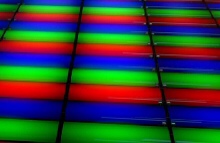 The retina display
The retina display
Plenty of tablets have 1280-by-800 resolution, enough to trump the iPad 2’s 1024-by-768. But no tablet has anything close to the new iPad’s retina display, with 2048-by-1536 resolution and 264 dots per inch. There’s nothing the tech industry likes better than a game of one-upmanship based on increasingly large numbers, so you’d think that every other company that makes tablets is now working to meet or beat the new iPad’s sky-high resolution.
Except it might not turn out that way. When the iPhone 4 showed up in 2010 with the original retina display, it didn’t prompt everybody else to meet or beat Apple’s spec. Instead, makers of Android phones concentrated on the physical size of their phones’ screen and generally offered ones with much bigger displays than the iPhone’s 3.5-incher. But they usually had lower resolutions than that of the iPhone, and always had lower dots per inch.
For all the iPad’s influence on other tablets, its 9.7-in. screen remains unusual — most competitors are either larger or smaller. Unlike the iPad, they’re virtually all widescreens. So it’s unlikely that the new iPad’s precise resolution will be a new standard. And even if other tablet companies want to match it, they might find it a struggle: to date, most of them have had trouble matching the iPad in pure bang for buck.
My guess: We’ll see a gradual uptick in typical tablet resolution, but not a rush to retina. (If we do, though, Windows 8 is ready: Microsoft designed it to support iPad-class resolution as well as more conventional screens.)
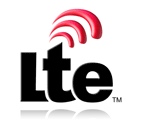 LTE 4G wireless broadband
LTE 4G wireless broadband
The new iPad is hardly the first tablet to have it. But it might be the first 4G tablet with excellent battery life — Apple says it gets up to nine hours on a charge when using LTE. Unlike many official battery ratings for mobile gadgets, that doesn’t seem to be a gross exaggeration. The company accomplished the feat, at least in part, by giving the new tablet a huge honkin’ battery.
All iPads have had better battery life than most competitors — sometimes vastly better. The notoriusly battery-draining LTE technology isn’t going to help reduce the disparity: USA Today‘s Ed Baig got only about 4½ hours out of the 4G version of Samsung’s Galaxy Tab 10.1.
I’m not sure whether the battery life of other tablets suffers because their makers don’t control nearly every aspect of their devices the way Apple does — it’s easier to be efficient when you design your own processors — or whether outstanding battery performance just isn’t that high a priority for other companies. It might be a bit of both. As 4G chipsets mature, battery life should improve across the industry, but I’ll be surprised (and pleased!) if garden-variety 4G tablets match the new iPad’s performance anytime soon.
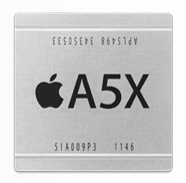 Apple’s A5X processor
Apple’s A5X processor
Like nearly every other tablet, the new iPad uses a system-on-a-chip processor based on ARM technology — in this case, one designed by Apple itself. The central processing unit uses dual-core technology, but the graphics processor, which has to pump four times as many pixels to the display as with the iPad 2, has four cores.
Apple usually tries to avoid the specsmanship game, but at the launch event for the new iPad, marketing honcho Phil Schiller said the A5X delivers graphics that are four times as zippy as those provided by Nvidia’s Tegra 3, used in Android tablets like this upcoming Acer model. As my colleague Jared Newman reported, some independent tests disagree with Schiller’s claim. But regardless of how the A5X and Tegra 3 stack up, the Tegra 3 already has four processor cores vs. the A5X’s two cores, so it’s not a fundamentally inferior chip.
Apple’s approach to processors is already at odds with the rest of the industry. It designs its own chips and optimizes them for its own gadgets but doesn’t obsess — usually — over raw speeds and feeds. Everybody else uses off-the-shelf chips, which often beat Apple’s products when it comes to technological bragging rights on matters such as clockspeed and quantity of cores. I see no reason why the new iPad will change matters here.
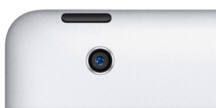 An improved rear-facing camera
An improved rear-facing camera
The iPad 2 had a rear camera that did respectable 720p video and murky still images; its replacement on the new iPad is a 5-megapixel model with some of the same optical features found in the iPhone 4S’s camera. It shoots nice stabilized 1080p video and decent (though not spectacular) snapshots.
Until there’s evidence to the contrary, I’m going to continue to assume that rear-facing cameras don’t have much impact on anyone’s decision to buy (or avoid) a tablet. Even if Apple had put an extraordinary camera in the new iPad, it wouldn’t have been big news.
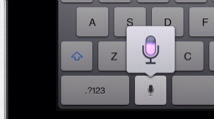 Dictation
Dictation
Speech-to-text input is already a standard feature on Android tablets, so Apple’s addition of it is pure catchup. Now, when Apple brings full-on Siri to the iPad — which has got to be a matter of time, right? — that will be something that demands a response from other tablet makers.
(More on Siri and the iPad: My colleague Matt Peckham mused on Siri’s absence and wondered whether Apple is working on something even better.)
Hmm. I seem to be saying that none of the iPad’s major new features are bound to have a profound impact on the rest of the market. You might interpret that as meaning I think Apple’s latest tablet doesn’t matter much. But that’s not what I mean. The retina display is likely to remain a unique selling point for months, if not years, and LTE gives shoppers one less reason to choose a tablet that isn’t an iPad. Both features should help Apple solidify the daunting lead it already has on the competition.
Still, when I think back on Apple’s launch event and the news that came with it, I’m convinced that the most significant tidbit may not have related to the new iPad’s hardware improvements at all. With iPhoto for the iPad, also unveiled at the launch, Apple introduced one of the meatiest, cleverest, most ambitious tablet apps to date. It couldn’t be done in quite the same way on anything but a tablet, and nobody’s done it for anything but the iPad.
Other tablets may add retina screens and battery-sipping LTE. They might have better cameras than the new iPad, and could even get Siri-like features before Siri shows up on the iPad. But we’ll know that the dynamics of the tablet market have fundamentally changed when there’s another platform — Android, Windows 8, anything — that’s a worthy iPad competitor when it comes to quality and quantity of built-for-tablet apps. Getting there will be way, way harder than bumping up screen resolution or ratcheting down power consumption. In fact, if anybody does it by the time the iPad 5 new-new-new iPad comes out, it’ll be quite an accomplishment.
More on the new iPad and its rivals: My colleague Jared Newman thinks it should be a wake-up call for Google. And I pondered what the arrival of Windows 8 will mean for the market.


